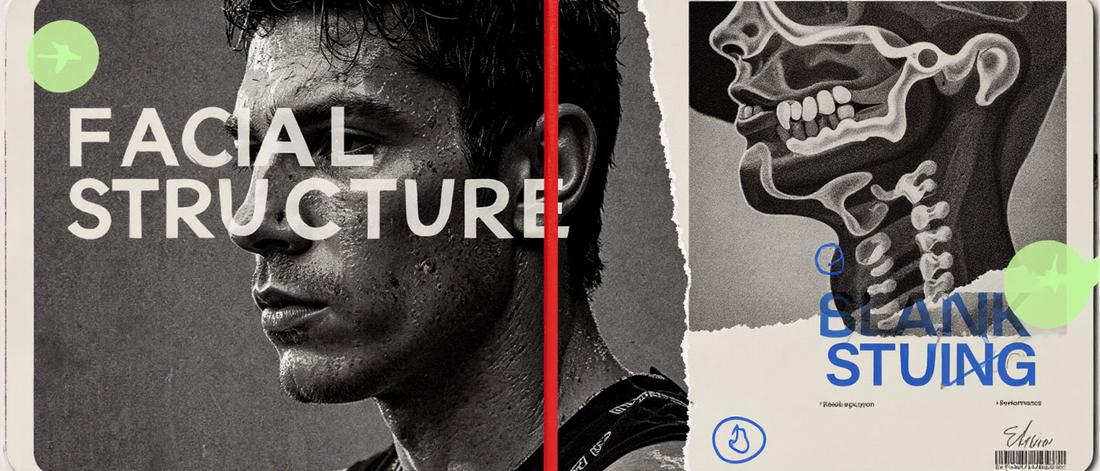
Facial Structure Change: A Review of Jaws
Share
How mouth breathing affects your jawline, posture, and airflow-yes, even now.
When the book Jaws: The Story of a Hidden Epidemic dropped, it cracked open a truth most of us weren’t ready for: modern faces are shrinking—and our breath might be to blame.
Authors Dr. Sandra Kahn (orthodontist) and Paul Ehrlich (biologist, Stanford legend) laid out a bold claim: mouth breathing, soft diets, and poor posture are reshaping our faces—leading to narrow jaws, crowded teeth, and smaller airways.
And while most of the research starts in childhood, the implications are lifelong. Because how you breathe still shapes how your face functions.
Wait-How Does Mouth Breathing Change the Face?
Think less TikTok jawline tips, more structural shift.
-
When you breathe through your nose, your tongue rests on the roof of your mouth. This pressure helps shape the upper jaw outward and forward—supporting a wider face, better alignment, and clearer airways.
-
Mouth breathing drops the tongue, weakens that support, and narrows the arch. Over time, the jaw compensates by growing down and back.
Result: long face, recessed chin, crooked teeth, smaller airway.
In kids, this affects bone growth.
In adults, it affects muscle tone, posture, airflow—and how your face holds tension.
So If I’m an Adult, Am I Screwed?
Nope. While bone growth slows post-adolescence, muscle, breath, and posture are totally retrainable.
Nasal breathing:
-
Improves tongue posture
-
Reduces tension in jaw and neck
-
Can subtly shift soft-tissue tone around the midface
-
Expands airway function and oxygen delivery
-
Lowers stress that shows up in your jaw and eyes (hello, clenched face energy)
Think of it like this: you might not grow a new jaw—but you can unlock the structure you already have.
What Jaws Gets Right (And What to Do With It)
The book is heavy on science and historical patterns—but here’s what we love:
-
It connects breathing to posture, jaw function, and sleep
-
It explains why modern humans have more crowded teeth and smaller airways
-
It offers a solution that’s not surgical: retrain the breath
And that’s where we come in.
+OXGN strips are a small mechanical nudge to bring your nose back online. Better airflow = better tongue position, less jaw tension, calmer nervous system—and over time, a more relaxed, balanced face.
TL;DR
| Issue | Why It Happens | What to Do |
|---|---|---|
| Narrow jaw, small airway | Mouth breathing drops tongue posture | Train nasal breathing daily + at night |
| Tension in jaw/neck | Disrupted airflow + stress load | Breathe slow, breathe through nose |
| Flat or tired facial tone | Poor muscle activation | Improve airflow, tongue position, nervous system balance |
Want to Go Deeper?
References
-
Kahn, S., & Ehrlich, P. R. (2018). Jaws: The Story of a Hidden Epidemic. Stanford University Press.
Link to book -
Guilleminault, C., Huang, Y. S., & Monteyrol, P. J. (2013). Upper airway resistance and craniofacial development. Sleep Medicine, 14(5), 499–505.
DOI:10.1016/j.sleep.2013.03.011 -
Harari, D., Redlich, M., Miri, S., Hamud, T., & Gross, M. (2010). Mouth breathing: adverse effects on facial growth, health, academics, and behavior. General Dentistry, 58(1), 18–25.
PubMed -
Yamaguchi, H., Sueishi, K., & Takada, K. (2011). Relationship between breathing pattern and tongue posture in children. Archives of Oral Biology, 56(10), 1191–1198.
DOI:10.1016/j.archoralbio.2011.01.005 -
Jefferson, Y. (2010). Mouth breathing: adverse effects on facial growth, health, academics, and behavior. The Journal of General Orthodontics, 21(2), 9–22.
Link